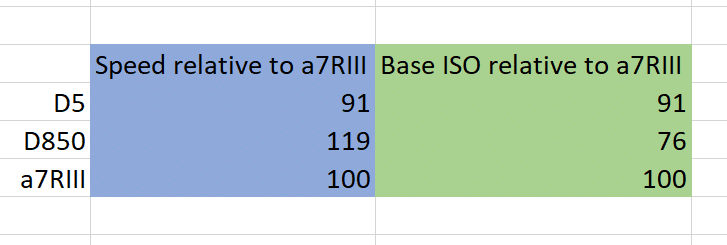This is one in a series of posts on the Sony a7RIII. You should be able to find all the posts about that camera in the Category List on the right sidebar, below the Articles widget. There’s a drop-down menu there that you can use to get to all the posts in this series; just look for “a7RIII”. This post is equally about the Nikon D850. You can get to the other posts about that camera in the same way; just look for “D850”.
In the last post, I compared the shadow noise performance of the Nikon D850 and Sony a7RIII. I did so looking at the set ISO, and made the implicit assumption that the two camera’s sensitivities corresponded to the camera-set ISO. But is that true? I decided to find out. I took an Otus 55/1.4, set it to f/4, and mounted it to the D850 and the a7RIII in turn. I also threw in the D5. Full disclosure. I use my D850 with the grip. I picked up the D5 thinking it was the D850, mounted the lens, clipped it into the tripod, set it up, and tripped the shutter. Only when I went to open up the memory card door did I realize my error. I made a series of exposures at ISO 100 and half a second with all three cameras. I brought the raw files into RawDigger and looked at the mean green channel signals in one small area in the images. Then I calculated what that said about the relative sensitivities of the three cameras.
At the same ISO setting, the D5 is about 1/6 stop less sensitive than the a7RIII. At the same ISO setting, the D850 is almost 1/3 stop more sensitive than the a7RIII. Compared to the a7RIII, the base ISO of the D850 is about 1/3 stop different, not the 2/3 stop you’d think if you just looked at the numbers on the cameras.
Some caveats:
- I don’t know which camera has the most accurate ISO setting. In fact, as far as I’m concerned, what with all the ways a manufacturer can rate the ISO sensitivities of sensors, I’m not sure that question has much meaning.
- Sample space of one of each camera. ‘Nuff said.
- Controls for the experiment were not perfect. Only one exposure per camera.
- I only looked at the green channel. That may not be a good stand-in for the sensitivities of the red and blue channels.

Is this sensitivity with respect to DNs? Or relative to highlight clipping?
As it turns out, with these cameras the difference between those two measures is immaterial. Nikon does WB prescaling, so I’d have to think about how to deal with some of those issues had I used the red and blue channels.
How about checking SNR^2 around 1-5% of full scale at base ISO? That should give us an approximate signal in e-, sidestepping gain issues.
Other than the resolution, are your results above just an adjustment of the slope of the amplifier – different gains on each of the sensor amplifiers?
When the manufacturers pick the base-ISO gain for a camera, they base it on including as much of the well capacity as they can while obtaining sufficient linearity. If they make the gain too high, images have too much photon noise. If they make it too low, there is unacceptable nonlinearity before the ADC clips.